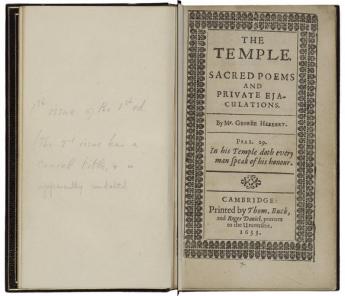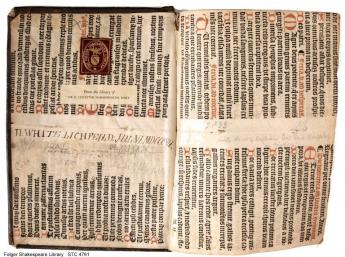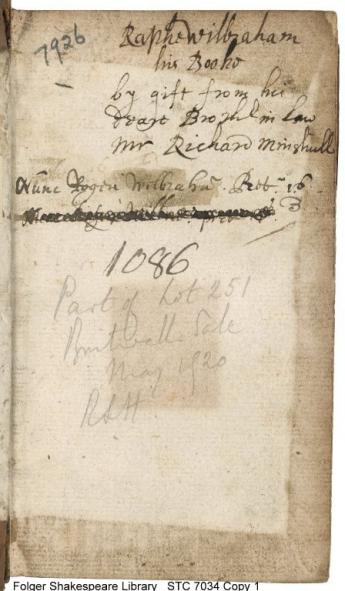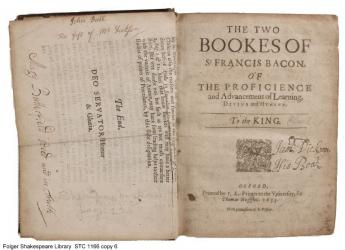News & Updates
Rare Books - When is an inscription not an inscription?
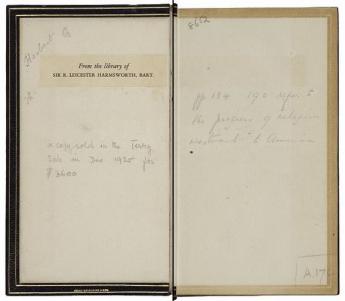
By Sarah Werner
Two folks identified the key elements of this month’s crocodile mystery in their comments: Misha Teramura correctly noted that the inscription in the middle of the page - “pp. 184-190 refer to the progress of religion westward toward America” - refers to George Herbert’s final poem from The Temple, “The Church Militant.” And David Shaw noted that the other inscriptions - “8652″ on the top left and “A176″ on the bottom right - look to be an accession number and a shelf mark.
But let’s back up for one moment to understand why I find these marks interesting. The book in question is a first edition of George Herbert’s The Temple (STC 13183). It’s an interesting work, and a popular one in the 17th century. And as you can see from the notations on the front pastedown and the recto of the first free flyleaf, it’s a work that was prized by later collectors.
This particular copy was owned by Sir Leicester Harmsworth before it came into the Folger Shakespeare Library collection, and its value is shown in part by the blue goatskin binding signed on the bottom turn-in by Riviere and Son. Its value is more obviously indicated by the inscription on the pastedown, “a copy sold in the Terry sale in Dec 1935 for $3600.”
There is another set of inscriptions opposite the title page and more marks on the rear pastedown.
To anyone interested in provenance or involved in the book trade, these markings will seem familiar: they’re the traces of booksellers and catalogers through whose hands the book passed. I suspect in this case that these inscriptions were written by a couple of different folks in the early twentieth century, given what we know about the dates supplied and the variations in handwriting.
Once you start looking, these traces of booksellers and librarians aren’t hard to find.
What catches my attention about all of these examples is the ways in which the inscriptions are visible on the item itself, but not the records of them in the catalog. While the catalog records for each of these include descriptions of various markings, they do not include mention of the penciled notes left by the booksellers and catalogers.
The record for our mystery item, for instance, describes the binding signed Riviere & Son and that it was owned by Harmsworth, but not the inscriptions. The record for The ceremonies for the healing of them that be diseased with the kings evil describes it as follows: “MS. contemporary price. Sewn into marbled paper wrappers. Provenance: inscription on t.p.: “Ri. [Richard] Newdigate” [Arbury Library ?].” The record for Sphæra civitatis notes the lovely manuscript waste paper and the provenance inscription of “Henr: White, Lichfield, 1807″ but does not quote the other provenance information on the flyleaf. The record for Donne’s Devotions transcribes the “Raphe Wilbraham his Booke by gift from his deare Brothr in law Mr. Richard Minshull” and “Roger Wilbraham” as provenance information, but only conveys the information about being part of the Britwell Court sale in 1920, rather than transcribing it.
I hadn’t really paid much attention to this category of marks not being cataloged until I wanted to find out more about the notation shown in the image above, a book that I discussed last month. I am sure that I have seen that “Shakespeare mentioned” type of inscription in Folger books before, and I have distinct recollections of my students noticing it in some of their books. I’d love to find out who was writing these inscriptions.
Was it a bookseller flagging items for the attention of Mr and Mrs Folger? An early librarian at the Library noting why it was in the collection? Even though I’ve been looking for more instances of it since discussing it last month, I can’t find any other examples. I’ve looked through my notes and through old student papers, but I’m not turning it up. And since it’s not recorded in any of the records in Hamnet, I’m at a temporary loss. I’m not sure I’m going to be able to make more progress on this, or at least any progress other than serendipitous happenstance.
I’m not necessarily recommending that catalogers note all such inscriptions in their records: how often do researchers want to have access to this sort of information when looking through a catalog? On the other hand, at what point does an inscription switch from being unremarked upon to being something from the historical past worth signalling? When is an inscription not an inscription worth noting and when does it become part of the record?
***
Sarah Werner is Digital Media Strategist at the Folger Shakespeare Library, editor of The Collation, and author of several books and articles on Shakespeare and the Renaissance. She blogs about books and reading on Wynken de Worde and is known in the Internet as @wynkenhimself.
This article was first published on The Collation and is presented here by permission of Sarah Werner. The pictures (courtesy of The Collation) show:
(1) the pastedown and first free flyleaf of George Herbert’s The Temple (STC 13183)
(2) penciled inscription facing the title page of George Herbert’s The Temple (STC 13183)
(3) front pastedown and flyleaf of Sphæra civitatis, authore Magistro Iohanne Caso Oxoniensi, olim Collegii Diui Iohannis Præcursoris socio (STC 4761)
(4) recto of front flyleaf of Deuotions vpon emergent occasions (STC 7034 Copy 1)
(5) verso front fly leaf and title page of The two bookes of Sr Francis Bacon, of the proficience and advancement of learning, divine and humane (STC 1166 copy 6).
